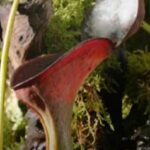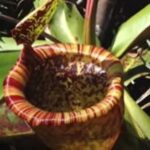As an Amazon Associate, this site earns commissions from qualifying purchases. For more details, click here.
Pitcher plants create food through photosynthesis, but they also eat insects to boost their nutrition and energy. Spiders make up a good part of their nutrition, but compared to other insects, the relationship is more complex. In many ways it benefits both as will be explained here.
Pitcher plants usually eat spiders, but some species like the crab spider have a symbiotic relationship with the plant. These spiders live in the pitcher and eat any prey that falls into the trap, then the leftovers are consumed by the pitcher plant.
Why Pitcher Plants Eat Spiders
Pitcher plants do not have to eat insects to survive. With water and light they can photosynthesize and produce glucose. However, spiders and other insects provide additional sustenance.
Pitcher plants require nitrogen, but it is missing from the soil they grow in. By eating spiders, butterflies and other insects, pitcher plants obtain nitrogen as well as calcium, potassium and other elements.
Because pitcher plants already get nutrients from the insects, they no longer need fertilized soil. Planting nepenthes or sarracenia in rich potting soil will kill them because they are used to getting nutrients from insects. If you want to grow nepenthes, use nutrient free potting media such as Halatool Natural Sphagnum Moss.
It is true that pitcher plants growing in an ideal environment can live without consuming spiders. But the extra resources provided by insect nutrients are still important. In other words, make sure your pitcher plants eat.
A well fed pitcher plant has a greater chance of surviving winter than one which does not eat. The extra energy nepenthes pitcher plants get from spider nutrients are used to produce more nectar, build stronger pitchers and generate more digestive liquids.
How Many Spiders Can Pitcher Plants Consume?
The amount of food pitcher plants can eat depends on several factors. The size of the food and how much nutrition the plant needs are the most important.
Most pitcher plants are fed once a month or once a week. However this only applies to indoor pitcher plants since they are fed manually. If you treat your pitcher plant as a a houseplant, you have to manage their nutrient intake.
Start with once a month and see how the plant responds. Keep in mind that if you are giving it large amounts of food, it might take several weeks to digest. Smaller prey will require less time to consume and can be given more frequently.
During the growth period, pitcher plants have to eat at least one bug a month. Increase to once a week if you have a large plant. You only need to feed one pitcher, but some give food to multiple pitchers.
You can give food to 2-3 pitchers if you are feeding small prey like ants. This applies to other types of food that you give it including Appetizing Mealworms Freeze Dried Crickets.
If your pitcher plant is outdoors, do not feed it. There are flies, wasps, moths, bees and other insects all around. Your plant will naturally draw these bugs and eat as many as it requires .
In some cases pitcher plants will eat just once a month. Sometimes they will consume more. Some outdoor nepenthes only need to feed one pitcher and is full. In other cases you might find insects in several pitchers. You should not worry about this as these plants will only eat as many bugs as needed. If the plant has already gotten its fill, the other insects will just remain in the liquids.
How to Feed Spiders to Pitcher Plants
Feeding pitcher plants is very easy. Take a spider or any other food, drop it into the pitcher and you are done. It is better to give it a dead spider because a live one might try to get out.
You do the same thing regardless of the food. You can give flies or fish flakes to pitcher plants for instance. Just drop them into the pitcher.
Once a prey -a spider in this example- has fallen into the trap, the digestive liquids will break it down. The plant digests the spider and is converted into nitrogen, phosphorus etc. This process can take weeks if the plant ate a large amount of food.
If there are crab spiders in the pitcher, they will eat the prey and leave the remains for the plant. Some nepenthes have larvae in the liquids which do the same thing. They consume the prey and whatever is left goes to the plant.
Why is My Pitcher Plant Not Eating?
There are many reasons why a pitcher plant may slowly or suddenly stop digesting. There are clues you can examine to find out the cause. Here are the most common.
Pests and Infestations. Pitcher plants may eat bugs, but they can also be afflicted with pests. Spider mites are very common during summer so look for signs of those. Deformed, half eaten leaves might mean there are thrips, tiny black pests in the leaves.
Mealy bugs, leafhoppers and other insects can also infest pitcher plants. Aphids afflict sundews as well as pitcher plants, so if you notice sudden changes in your nepenthes or sarracenia, look out for these bugs.
Diseases. Both nepenthes and sarracenia can suffer from fungal diseases. These infections can spread through the roots and into the leaves and pitchers. Unless treated these diseases can be fatal. Fertilizing the soil can also cause an infection.
Extreme temperatures. Most nepenthes and sarracenia pitcher plants prefer a temperature range at 65-85 degrees F. Some species can tolerate up to 90 or 100 degrees for a brief time. However, too much heat dries up the leaves and the liquids inside the traps.
Without those liquids it is impossible for the plant to hold prey down. And the high temperature affects its other functions as well. So do not be surprised if your pitcher plant does not eat during very hot days. The solution is to put some cover on the plant or give it partial shade.
The same thing can happen during the cold season. While sarracenia plants go dormant, nepenthes do not. They prefer to be in the same temperature so they cannot survive winter outdoors. Take your nepenthes indoors and provide an adequate environment so it can survive.
Pitcher Plants and Crab Spiders: a Symbiotic Relationship
While pitcher plants eat most spiders, the yellow and red spider crab have developed a unique relationship with the plant. In many ways it is mutually beneficial.
Research conduced at the National University of Singapore revealed that crab spiders live in the pitchers. They wait for a prey to fall into the trap and eat them.
While crab spiders are stealing food from the pitcher plant, the plant also benefits in two ways. One, the spiders leave the remains for the plant to consume. Second, these spiders are able to catch prey that would otherwise be difficult for the pitcher plant to lure.
What researchers learned is that pitcher plants with crab spiders catch more prey than those without. So while the spiders take some of the food, they provide more than enough for the plant.
Crab spiders also simulate the colors of flowers, drawing pollinators to the plant. Apart from giving pollination a boost, crab spiders and related species can detect distress signals from pitcher plants when they are being eaten by beetles and other insects. The spiders will come and eat those insects.
In return, the pitchers serve as a safe haven for these spiders. However there are still instances where the plant ends up eating these spiders. They usually grab prey as they fall into the liquid then use their silk to climb back up. But sometimes they are unable to get out of the liquids and get digested.
Conclusion
Pitcher plants are easy to care for when you know how, but they are quite complex organisms. Their unique relationship with crab spiders shows that there is more to them than just eating insects.

My fascination with carnivorous plants began many, many years ago with Venus Fly Traps. Now I am more than happy to impart what I know with other enthusiasts and those who are curious about meat eating plants.



